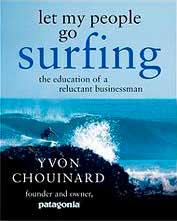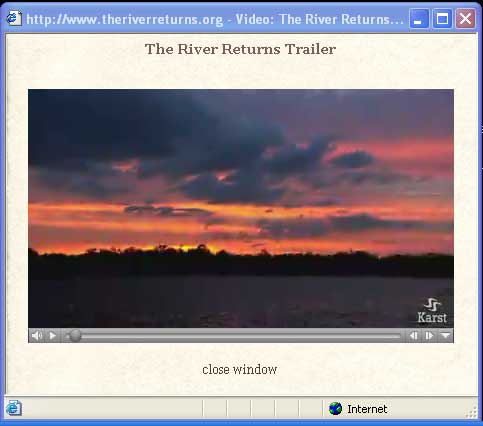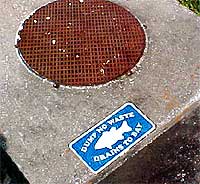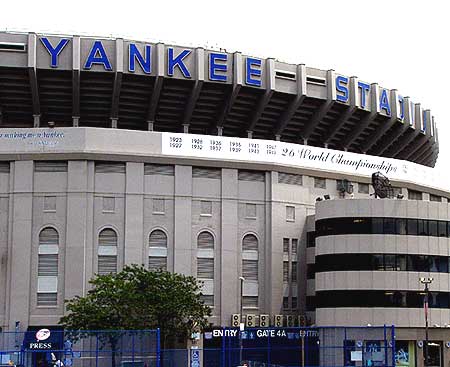
Step down to the street from the 161 Street subway platform in the Bronx and you’re unmistakably in the heart of Yankee country. Blue and white painted buildings stretch for blocks in either direction selling wares adorned with the overlapping “NY” logo, memorabilia and four-dollar hot dogs. Every day is a carnival held in celebration of one of the most storied franchises in professional sports.
Look across the street and you’re confronted by the towering limestone façade of the House that Babe Ruth built—Yankee Stadium. Built in 1923, the stadium has been home to a team that won one out of every four World Series championships in the twentieth century. Fans refer to it as the “front office of Major League Baseball,” alluding to the organization’s influence within the league. The Yankees are valued at $950 million, according to Forbes Magazine, a figure nearly double that of the nearest competitor. The Yankees are nothing less than an icon of America and New York City.
And they want a new stadium—nothing ostentatious, just a sensible, attractive structure located a few hundred feet north of their current digs. After years of wrangling over finances and navigating New York’s political terrain, the Yankees agreed to fund the entire $800 million stadium project, provided that the city chips in $400 million for "infrastructure improvements." Chief among the improvements are land for new parks and an additional Metro North stop. State law stipulates that the Yankees must replace an equivalent amount of green space elsewhere in the Bronx to that which the new stadium consumes.
The upheaval will affect the area between 161 and 164 Streets-- blocks currently reserved for McCombs Dam and John Mullaly parks. At the site's northern edge, the future location of the stadium’s outfield seats, sits an equipment shed where Willie ("just Willy is fine," he says) coordinates a youth tennis league.
"I'm kind of biased," Willie says, when asked about the new stadium. "Groundbreaking is supposed to happen in the spring of 2006. If they don't move the tennis courts by the beginning of summer, then the kids will lose the whole season."
The twenty courts are slated to be moved due west of the stadium to the bank of the Harlem River. The Bronx is set to receive 70 parks improvement projects, according to a speech by Mayor Michael Bloomberg at a ceremony for the newly founded Barretto Point Park. The Bronx is one of the greener boroughs in New York City with 191 residents per acre of parkland. It ranks second behind Staten Island and seems bucolic compared to Manhattan's 569 residents per acre of parks. The city envisions a bold "South Bronx Greenway" by turning several miles of largely abandoned industrial properties into public access waterfront.
But critics of the stadium plan accuse the city of taking on too many costs in pandering to private interests, and some Bronx residents remain skeptical. "Harlem River Drive is too far away," says Willie, waving his hand towards the river about four blocks from where he sits. "The community center across the street is staying, so if the tennis courts are blocks and blocks away, they'll be isolated. You don't know if it's safe for kids to walk down there."
"And you don't know what's in the ground, like soil contamination from the plants along the river," he says. A South Bronx resident all of his life, he’s cautious of redevelopment plans, whether proposed by private interests or City Hall. He’s witnessed inequities in his neighborhood over real estate, where “mixed income” housing inevitably ends up favoring the affluent, he says. "The Yankees say they need a new stadium, but what they mean is they want more luxury boxes. The stadium will actually have fewer seats. None of this stuff is ever for the average person."
"They want to move the sod from the original field and keep the [stadium’s] original facade. They have the original sod and facade right where they are now," ha adds, before echoing a common theme among sports fans: "It's that building" -- he says, jabbing at the air in the direction of the old stadium-- "that has the mystique. That's where Babe Ruth
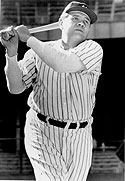
pointed up to the stands and hit home runs. The new building won't have that mystique." Some Yankees fans have pushed to declare the current stadium a protected historical landmark.
Another concern voiced by environmental and community groups is traffic. According to project planners, fewer seats mean fewer vehicles commuting to games. But Teresa Toro, New York City Coordinator for the Tri-State Transportation Campaign, believes otherwise.
“It is not the number of seats in the stadium but the number of parking spaces that influences how many people will drive,” Toro said at a public scoping meeting at the Bronx Museum of the Arts in July. “This project includes the construction of four new parking garages. Although the new stadium has fewer seats, the Project involves constructing many more parking spaces – from 7,079 to 11,044 in a half-mile radius.”
The American Lung Association gives low marks to New York City’s air quality. A 2004 report found one million residents suffering from asthma including 300,000 children. The city’s asthma mortality rate was the highest in the country last year.
Toro chided planners for favoring parking garages to a new mass transit station. “[The Department of Transportation’s] Bronx Arterial Needs study also found that many people who usually take Metro North drive to Yankees games so they don’t have to return to Grand Central or 125th Street to catch a train,” she said. “Unfortunately, proposals to build a Metro North station at Yankee stadium have been languishing for years. Instead of displacing parkland for parking, why can’t the Yankees bring this project to fruition?”
Directly north of 161 Street from Yankee Stadium are a running track and a group of covered bleachers. Both are filled with activity on this mild summer afternoon. Beside the track is Babe Ruth Field—comprised of two baseball diamonds with imperfect edges that share an outfield. After the tennis courts, the track and the backstops are all cleared away, the field will hold the new Yankee Stadium's home plate.
By Gregory Yanick - New York
Greener Magazine Staff Writer







 The first annual 'Carnival of the Green' starts this fall. From green blog to green zine the Carnival will be hosted each week by a different site. Like any carnival, we'll pull into town each Monday with a new 'greener' hosting the Carnival.You will be amazed and astounded by all the wondrous 'green' portents, alchemy and patent medicine shows; more green, sustainable and earth friendly wonder than your parents would ever allow.
The first annual 'Carnival of the Green' starts this fall. From green blog to green zine the Carnival will be hosted each week by a different site. Like any carnival, we'll pull into town each Monday with a new 'greener' hosting the Carnival.You will be amazed and astounded by all the wondrous 'green' portents, alchemy and patent medicine shows; more green, sustainable and earth friendly wonder than your parents would ever allow.